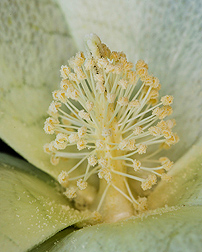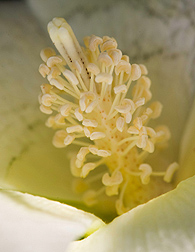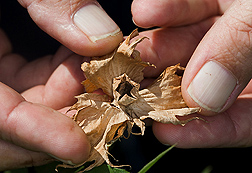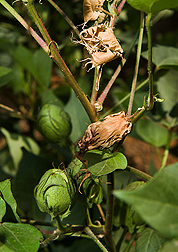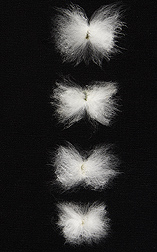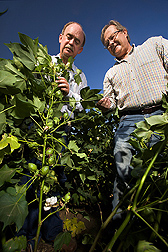Breeding Better Cotton
|
|
People expect a lot from cotton.
Consumers want durable, comfortable fabrics. Producers want easy-to-manufacture textiles. And growers want hardy, thriving plants. Uniting these traits in individual cultivars is the goal of ARS cotton breeders at the U.S. Arid-Land Agricultural Research Center at Maricopa, Arizona.
In the center’s Plant Physiology and Genetics Research Unit, plant geneticist Richard Percy—now with the ARS Southern Plains Agricultural Research Center at College Station, Texas—has bred new cotton lines with qualities to please growers, fabric manufacturers, and consumers.
The Heat Is On
Pima—an extra-long-staple cotton—produces long, strong fibers that are suitable for high-quality products such as luxury sheets and sewing thread. But historically pima plants have been susceptible to heat. They start exhibiting symptoms of heat stress when their leaf canopy temperature—the temperature of a plant itself, as opposed to the air around it—reaches about 82˚F. That heat stress becomes severe enough to inhibit reproduction at around 86˚F.
|
|
Over the last five decades, Percy and his colleagues have bred and released heat-tolerant and heat-avoidant pima germplasm lines, which the commercial seed industry has used to create new varieties that can withstand extreme temperatures.
How robust are the new cotton varieties? In the summer of 2006, temperatures in the cotton belt rose above 100˚F and hovered there for several weeks. Despite the oppressive heat, irrigated pima crops grown in Arizona and California’s San Joaquin Valley thrived.
The endurance of the 2006 crop is a testament to the hardiness of the new varieties and to the positive impact of Percy’s breeding program. In 2003, Cotton Incorporated asked Percy for help improving heat tolerance and fiber quality in upland cotton, a short-staple species, which makes up most of the U.S. cotton crop. Because upland is grown in many different states, Percy wanted to ensure that the new lines could adapt to a variety of climates.
“Developing heat-tolerant breeding materials is a good goal, but it’s not really a useful achievement unless the new lines are regionally adapted and can be used as parents to produce competitive cultivars elsewhere,” he says.
|
|
To ensure that the new cotton lines could grow throughout the Cotton Belt, Percy enlisted ARS and university scientists in Georgia, South Carolina, Louisiana, and California to test them. In 2006, as a result of their collaboration, ARS and Cotton Incorporated released three upland cotton lines with superior fiber quality and heat tolerance.
Those lines have been picked up by about two dozen commercial seed companies and breeders for further development. Today, the ARS program continues to produce new lines of upland cotton, and scientists are working to further improve upland’s heat tolerance.
If It Can’t Take the Heat . . .
The lack of effective selection tools for heat tolerance is one of the biggest challenges scientists and breeders face. For decades, the end product was the only indicator available. Crops that produced well in hot years were clearly heat tolerant—or were they?
|
|
In fact, some crops exhibit a quality known as “heat avoidance,” which means they have heat-coping strategies without actually being heat tolerant. Pima cotton exhibits both characteristics. What’s the difference? Imagine a group of people weathering the summer heat. Some have metabolisms that keep them cool in hot weather. The others have air conditioners. At the end of the day, everybody’s comfortable, but only the first group is truly heat-tolerant—and the second group has a much higher energy bill.
The same principle applies to plants. Some cotton plants—for example, those that maintain open leaf pores, called “stomata,” during periods of high temperature—can avoid heat by using evaporation to cool off. Heat avoidance does not work as well when humidity is high or water is limited, but the characteristic can help some plants to withstand the hot weather.
|
|
“Avoidance is probably not as desirable as true tolerance, but it has allowed pima to be a successful crop under heat stress environments,” Percy says.
Because heat tolerance is more reliable, the scientists would like to develop tolerance-specific selection tools to assist their breeding efforts. But it’s virtually impossible to differentiate between avoidance and tolerance simply by examining final crop yields. To identify better tools, ARS plant physiologist Steven Crafts-Brandner is examining heat-tolerant and heat-sensitive cotton plants.
One potential characteristic that could be used to identify heat-tolerant lines is the rate of dark respiration, a continuous process in which mitochondria within a plant’s cells oxidize carbohydrates to create energy. Crafts-Brandner and Percy suspect that there is a relationship between efficient nocturnal carbon use and heat tolerance.
Cotton plants make more starch during the day than they require for growth. The excess is stored in the chloroplast, where photosynthesis occurs. At night, starch is broken down via respiration and other metabolic processes and used to support new growth, such as cotton bolls.
“Much of the carbon from starch is respired as carbon dioxide to produce the energy needed to support new growth,” Crafts-Brandner explains. “If, however, the respired carbon exceeds the amount required for optimal growth, that carbon may be inefficiently used, and there will be less available for the plant to deal with the heat.”
To test this theory, Percy selected three upland and three pima cultivars, choosing a mix of heat-tolerant and susceptible plants. The scientists have been monitoring the cultivars’ rates of dark respiration and photosynthesis throughout the day. The study is not yet complete, but Percy and Crafts-Brandner have made some significant observations.
For example, the cultivars with the greatest heat tolerance generally have lower rates of dark respiration and more efficient use of carbohydrates. If ongoing studies support these observations, the scientists may be able to use these traits to improve the cotton-breeding program.
Establishing a real genetic link between heat tolerance and respiration could have many benefits.
“It would give important insight into the underlying physiological mechanisms that regulate the response of cotton—and other crops—to environmental stresses,” Crafts-Brandner says. “Our breeding program would benefit by having a more reliable indicator of heat tolerance to use in selecting parent plants.”—By Laura McGinnis, Agricultural Research Service Information Staff.
|
|
This research is part of Plant Genetic Resources, Genomics, and Genetic Improvement (#301) and Plant Biological and Molecular Processes (#302), two ARS national programs described on the World Wide Web at www.nps.ars.usda.gov.
Richard G. Percy is with the USDA-ARS Southern Plains Agricultural Research Center, 2881 F&B Road, College Station, TX 77845; phone (979) 260-9311, fax (979) 260-9333.
Steven Crafts-Brandner is in the USDA-ARS Plant Physiology and Genetics Research Unit, U.S. Arid-Land Agricultural Research Center, 21881 North Cardon Ln., Maricopa, AZ 85239; phone (520) 316-6358, fax (520) 316-6330.
Scientists Target New Cotton Foe
Today, ARS-developed pima cotton plants can flourish in the long, warm days of a typical California summer. (See story above.)
But a newly emerging plant disease, first detected in the Golden State in 2001, threatens to cast a shadow on this bright picture. The invader, called “FOV race 4,” is caused by the soil-dwelling microbe Fusarium oxysporum f. sp. vasinfectum. The fungus can clog a plant’s plumbing, or vascular system. As its leaves turn yellow, wilt, and die, the afflicted plant may weaken, and its yields of fluffy white bolls may plummet.
That’s why scientists Mauricio Ulloa, a plant geneticist, and Rebecca Bennett, a plant pathologist, both working north of Los Angeles at the ARS Western Integrated Cropping Systems Research Unit in Shafter, California, have teamed up with colleagues like Richard Percy, of ARS, and Michael Davis and Robert Hutmacher, of the University of California, to come up with affordable, Earth-friendly ways to fight the fungus.
Already, they’ve developed four new kinds of Fusarium-resistant plants that produce pima cotton—the kind that processes into pricey, premium fabrics for upscale apparel or for bedding, towels, and other products for the home.
The scientists offered these parent pimas, known as SJ-07P-FR01 through -FR04, to cotton breeders and researchers in 2007. The plants rank as the first publicly owned pimas that have good resistance to race 4; good-to-superior fiber length, which is important to fabric quality; and moderate yields.
Now the scientists are testing hundreds of upland cotton plants—the type that produces excellent less-expensive fibers.
In related studies, Ulloa and coinvestigators are delving more deeply into cotton’s genetic makeup to find markers—genetic material that indicates the presence of genes of potential interest. The researchers have already identified a significant number of markers to evaluate as indicators of Fusarium resistance.
Bennett is exploring ways to quell Fusarium in the soil. In a 3-year study, she’s testing several soil fumigants as well as solarization, in which soil covered with plastic tarps might capture enough heat from the sun’s rays to zap the fungus. The fumigants are “too expensive to use on a widespread basis in cotton,” says Bennett, “but might be economical for spot-treating highly infested sites.”
There’s more, like an indoor study—in collaboration with plant pathologist Tom Gordon of the University of California—in which Fusarium will be specially equipped with a gene that causes it to fluoresce a bright green when viewed with ultraviolet light in the lab. The telltale glow will make it easier for Bennett to spy on the fungus and—perhaps—to find a way to bring about the unwelcome microbe’s demise.—By Marcia Wood, Agricultural Research Service Information Staff.
This research is part of Crop Protection and Quarantine, an ARS national program (#304) described on the World Wide Web at www.nps.ars.usda.gov.
Mauricio Ulloa and Rebecca Bennett are in the USDA-ARS Western Integrated Cropping Systems Research Unit, 17053 N. Shafter Ave., Shafter, CA 93263; phone (661) 746-8009 (Ulloa), (661) 746-8002 [Bennett], fax (661) 746-1619.
"Breeding Better Cotton" was published in the February 2008 issue of Agricultural Research magazine.







